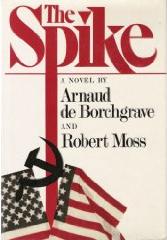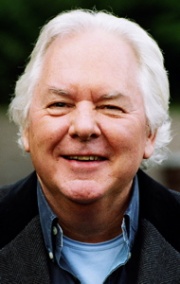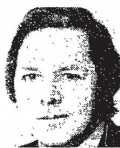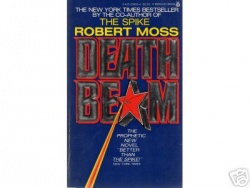Difference between revisions of "Robert Moss"
(→Publications and Propaganda: fred landis video) |
Tom Griffin (talk | contribs) (→Affiliations) |
||
| Line 71: | Line 71: | ||
*[[Unification Church]] | *[[Unification Church]] | ||
*[[Institute for the Study of Conflict]] | *[[Institute for the Study of Conflict]] | ||
| + | ===Conferences=== | ||
| + | *1979 [[Jerusalem Conference on International Terrorism]] | ||
==Publications== | ==Publications== | ||
Revision as of 23:14, 14 April 2011
Robert Moss is now a 'shamanic counselor', and 'dream teacher' but was once a journalist and right-wing activist who specialized in anti-communist writing. He was editor of The Economist's Foreign Report during the 1970s and a columnist with the Daily Telegraph. [1]
Contents
Career
Moss started out as an academic in Australia before moving to England. He told CBS Radio in 1985: “I started as an academic, I was a university professor in Australia before I became anything else. I think I was the youngest university professor in the country at the age of 21 – in Ancient History by the way. I wrote various theses, I had various academic degrees and awards.” [2] After moving to England, Moss worked for The Economist during the 1970s and also became involved with a number of right-wing propaganda groups associated with his friend Brian Crozier. He was a regular contributor to the publications of Forum World Features [3] and its successor organisation the Institute for the Study of Conflict, both funded by the CIA. He was also a director and founder member of the National Association for Freedom [4] (later the Freedom Association) and was one of a number of figures from that group which met privately with Margaret Thatcher in March 1976. [5]
A biographical note published in 1981 states that Moss was a visiting lecturer at the Royal College of Defence Studies in London and the Nato Defence College in Rome. [6]
Publications and Propaganda
<youtube size="medium" align="right" caption="Fred Landis discusses Robert Moss and CIA propaganda">mayeuuZWgkQ</youtube> During the 1970s Moss wrote a number of publications for the right-wing think-tank the Institute for the Study of Conflict (ISC). ISC had been established in May 1970, principally by Moss' friend Brian Crozier, and had grown out of the CIA funded propaganda outfit Forum World Features. [7] In October 1970 ISC published the 8th issue of its journal Conflict Studies (the third issue of the title published by the ISC). It was authored by Moss and entitled 'Urban Guerillas in Latin America'. [8] Moss also authored the 14th issue of the journal, which was published in August 1971. [9] The issue was called 'Uruguay: Terrorism versus Demoracy'. The theme of a battle between 'terrorism' and liberal democracy was a popular one amongst the anti-insurgency writers who frequented ISC, and the title was borrowed by the terrorism expert Paul Wilkinson when he wrote the 67th issue of Conflict Studies in 1976 under the title 'Terrorism versus Liberal Democracy'. [10] In 1971 Moss also wrote 'The Security of Ulster', a section of the Institute for the Study of Conflict paper 'The Spreading Irish Conflict', whose main author was ISC's administrative director Iain Hamilton. According to Paul Foot:
Moss did not seem at all interested in reforms, settlements or solutions: only in the first condition of any of them - the adoption of the toughest possible military line. He had unlimited faith in the British Army, which had conducted him around the Six Counties. 'The British Army,' he concluded, is the only force in the Province that can claim to be non-partisan.' [11]

In 1971 the International Institute for Strategic Studies published Moss's report Urban guerrilla warfare. The publication included in its appendix the 'Mini-manual of the Urban Guerrilla' by the recently deceased Brazilian Marxist Carlos Marighella. [13] In 1972 the report was republished as a book titled, Urban guerrillas: the new face of political violence. [14] The book received favourable reviews in the British press. Writing in The Times, Christopher Hitchens called it 'highly intelligent and useful'. He wrote that Moss was, 'not sympathetic to social revolution' but was also not 'an apologist for tyranny'. [15] Robert Thompson, counter-insurgency expert and founder of the Institute for the Study of Conflict called it 'An excellent book and a most realistic analysis of this problem'. [16]
1974, the year that Forum World Features was closed, Moss wrote two articles for the CIA backed propaganda outfit/news agency. One entitled ‘Brussels – centre of subversion’ described him as ‘Brussels FWF correspondent’, and was subtitled ‘Widespead recruiting by Trotskyite 4th International. The second was an exclusive interview with the racist MP Enoch Powell. [17]
Chile's dictatorial experiment
During this period Moss wrote a number of articles and books which were used by the CIA and its allies in the Chiliean military to destabalise the government of Chile, and then to support the military government after the 1973 coup. According to Fred Landis:
In 1971, the CIA's Station Related Mission Directives for Chile specified under priority "B" that friction be created between the socialist regime in Chile and the military dictatorship in Argentina by planting "black propaganda" to the effect that Allende was encouraging the establishment of a communist guerrilla training camp on the border. Instructions were given to the CIA station in Santiago to plant this story in several key media in order to launder it for replay in Chile. One of the most influential was the Economist of London
The correspondent for the Economist in Chile was Robert Moss. He found an agronomy student, Jose Gregorio Liendo, working in a remote are bordering Argentina, elevated him into the Che Guevara of Chile, and bestowed upon him the title of "Commander Pepe." This fabrication was such a success that it led to the arrest and execution of the non-existent "Pepe" – but the real Liendo – at the time of the military coup. Moss took a 20-hour flight from London to Santiago, and continued all the way to Valdivia to interview "Pepe" before he was executed. This interview, replete with sarcasm for the hapless Pepe and his wife, was included by Moss in the last chapter of his CIA-financed book, Chile's Marxist Experiment. [18]
On 20 March 1973 the CIA subsidised weekly SEPA aimed at Chilean military officers published a front page article by Moss carrying the headline: ‘Robert Moss. An English Recipe for Chile – military control.’ Moss was identified as a British sociologist. After the coup against Allende’s democratic government, the editor of SEPA Raphael Otero became the military regime’s official spokesperson. [19]
That same year the Institute for the Study of Conflict and the intelligence connected U.S. think-tank the Center for Strategic and International Studies co-published The Stability of the Caribbean. The book was edited by Moss and included contributions from CSIS's director of Latin American James Theberge and the head of the Institute for the Study of Conflict Brian Crozier. [20] In 1974 Moss and Theberge appeared before a Congressional Sub-Committee hearing on the U.S. and Chile during Allende's rule. Theberge read his article 'Kremlin's Hand in Allende's Chile', which he had prepared for a CSIS conference also attended by Moss. The first line of his article quoted a 'brilliant Peruvian Communist' who happended to have been on the CIA payroll since 1950 and had worked on propaganda operations in Mexico with Willliam F. Buckley. [21]
Moss' book Chile's Marxist Experiment was published shortly after the CIA back coup against the democratic government of Salvador Allende as part of the publishing operation of Forum World Features. The introduction to the book stated that Washington had nothing to do with the military coup – something later conceded by Moss. [22] The book was used extensively as an English and Spanish language propaganda tool by the mlitary government.
The Chilean ambassador in London negotiated an order of 10,000 copies of the book, double the original print run. 8,500 of those copies were to be sent directly to the Chilean Embassy in Washington and 1,500 were sent to the Chilean Embassy in London. Both Embassies made the book available free of charge as part of ‘a package of glossy Government publications defending the military junta’s record on human rights and economic development.’ The Chilean Embassy in London told The Guardian: “Mr Moss is a very good friend of ours…We give the book away because it is an objective study and it is also good for us.’ [23] In December 1976 The Guardian reported that ‘bewildered academics in America have received as many as three copies of the book.’ [24]
A Chilean publishing house called Gabriela Mistral regime published 15,000 copies of the book. The publishing house was wholly owned by the military regime and run by a Chilean man called Thomas P. McHale. Before the coup McHale had run the books department of the Institute for General Studies in Santiago, which received 75 percent of its funding from the CIA in 1973 and according to a US Senate Committee was staffed by ‘CIA collaborators’. [25]
Fiction
From the mid-1970s Moss began to focus on fiction to promote the same ideological themes that characterised his scholarly work. His first offering of this type was the semi-fictional work The Collapse of Democracy. First published in 1975 the book opened with a dystopian fable set in 1985. According to The Times: 'Inflation, as a conscious political strategy, has been used to destroy the middle class, combined with the elimination of the private sector and the redistribution of wealth by punitive taxation…England has slipped by way of Socialism into Communism.' Buckingham Palace has become the 'Ministry of Equality', the National Union of Journalists has destroyed the free press, and a former student member of the Anglo-Soviet Friendship Society heads the military. [26] In the review The Times described Moss as ‘no MacArthurist witch-huner’ and ‘no hysterical right-winger. He is rather a liberal democrat, as distinct from a social democrat…’ [27] The prescriptive sections of the book argued for the type of neoliberal measures later adopted by the Thatcher government. In an article titled 'Neoconservatism rides forth', his colleague at The Economist summarised the book's message as follows:
If we yield too much power to bodies that are elected (for example, governments and trade unions) then an undue influence will be wielded over us by even the most inefficient and extremist of the 2% who want to participate in public affairs; this is a deprivation from the freedom of the 98% of us who just want to be discriminating and choosey consumers of good government like we are discriminating and choosey consumers of good soapsuds. The pons asinorum of modern politics is to realise that even the poorest housewives are getting a better choice of soapsuds (by buying them in supermarkets) than they are getting of politicians (between, say, Nixon or McGovern or Wilson or Thatcher at the ballot box).
One way out over the next few decades, so as to return power to the 98% and also to bring back efficiency, will have to be to cut sharply the proportion of gnp spent by governments, and to return a lot of present public services to rule by the marketplace. Much of the battle will be to break through the resistance of the vested interests which have gained in amour propre while the 2% of the bossy have grabbed too much power from the 98% of the intelligently uninvolved. [28]

Five years later Moss began writing spy thrillers based on communist plots to undermine the United States. The purpose of these books was to demonise the Soviet Union in the popular imagination. Moss was quite open about their propagandistic purpose. He is quoted by the Globe and Mail as saying: “One thing that troubles me about many recent spy novels is that the KGB rarely figures as a plausible villain. There has been a rash of productions in which the hero goes out to do battle with the wicked CIA, or some multinational corporation or a rightist government. It's high time the Soviets were shown in their true colors, in a form accessible to the average readers.” [29]
In 1980 Moss produced his first novel in collaboration with the American right-wing journalist Arnaud de Borchgrave. The two men first met in 1972 when de Borchgrave was hiding out in England following a threatening phone call concerning an article he had written on the Munich Massacre. He stayed with his cousin who was chairman of The Economist and introduced de Borchgrave to Moss after the former asked if anyone at The Economist knew anything about terrorism and could advise him on his predicament. [30] The two men stayed in touch and as de Borchgrave explained: “We eventually realized that between us we knew most of the intelligence directors in the Western world. We decided to pool these assets to gain access to the major defectors from Soviet intelligence, to see what they could tell us about 'disinformation' and manipulating the media.” [31]
The result was a bestselling novel called The Spike ('Spike' is newspaper jargon for when an editor refuses to run a journalist's story). It told the story of 'a young journalist who, in an effort to prove his suspicion that the media have made the public insensitive to the Soviet Union's plans for global supremacy, ferrets out the facts in Vietnam, Hamburg, Rome, Moscow and even the White House.' [32] The book was marketed as ‘The chilling tale of KGB manipulation in the Western media: a story so EXPLOSIVE it can only be told as fiction!’ [33]
A year after The Spike, Moss produced his first solo fictional work, Death Beam. The original title of the book was Death Star, but it was changed after Lucas Films threatened legal action. [34] The plot of the novel centred around the Russians developing the ‘Death Beam’, described in the book as 'the most efficient weapon of mass destruction ever known to man.' [35] Whilst the Russians develop the 'death beam' a ‘political myopia’ in Washington prevents the United States from properly confronting the Soviet threat. [36] Business Week summarised the plot of the novel as follows:
Russians are not only winning the military race with the U.S. but also using an extensive network of spies and agents to mislead public officials and ordinary citizens about their strength and aggressive intentions. As the novel opens, Leonid Brezhnev is dead, and in a ruthless power struggle taking place within the Kremlin, the Soviet Defense Minister decides that the time has come to bring the U. S. to its knees. Unlike this country [The U.S.], the Soviet Union has carried out successfully' a crash program to develop a high-energy particle beam, or "death ray," that, put into space, can annihilate large areas of the U.S. A race gets under way to deter-mine whether the U.S. will recognize and foil the danger in time. [37]
The New York Times described the book as ‘odious’. It criticised what is called its ‘consistent undertone of right-wing paranoia’ and said the book gave ‘the impression that the very concept of a free press is somehow repugnant to the author.’ [38] The Washington Post criticised its literary style, saying that despite 'the energetic advertising on its behalf' it was an ‘awful’ book, ‘execrably plotted and execrably written’ [39]
Moss had copies of the book delivered to President Reagan, his White House chief of staff Edwin Meese and the Secretary of State Alexander Haig. [40] On 10 November 1981 Arnaud de Borchgrave hosted a book launch party for Death Beam at his apartment in Washington. There were around 200 guests, including most of the senior Republicans from the Reagan administration. Guests included White House chief of staff James Baker, national security adviser Richard Allen, special assistant to the president for political affairs Morgan Mason, counselor Edwin Meese, CIA director William Casey, Republican direct-mail czar Richard Viguerie and International Communication Agency director Charles Wick. [41] Morgan Mason told the Washington Post: “Arnaud and Robert are good guys, and they're known to be on our side, so to speak. They are philosophically attuned to the administration, and we want to embrace them.” [42]
Moss and de Borchgrave later collaborated again on Monimbó, which was published in 1984. The novel centred around a New York journalist who uncovers a Cuban led plot to, as the Washington Post put it, 'foment racial insurrection and create moral decay in the United States'. [43]
Moss authored two more cold war propaganda novels, Moscow rules and Carnival of spies, published in 1985 and 1987 respectively.
Postings
- Chile 1970-1972
- Portugal 1974-1975 (source: nameBase)
Awards
- Max Schmidheiny Foundation: Freedom Prize 1979[44] (First recipient of the award).
Affiliations
- Noam Chomsky and Edward Herman write: 'Robert Moss was editor of a dubious offshoot of Britain's Economist called "Foreign Report" which specializes in sensational rumors from the world's intelligence agencies [45]
- Daily Telegraph
- Maldon Institute
- The Economist
- Central Intelligence Agency
- Unification Church
- Institute for the Study of Conflict
Conferences
Publications
- Robert Moss, 'Urban Guerillas in Latin America', Conflict Studies, No.8 (October 1970)
- Robert Moss, 'Urban guerrilla warfare, by Robert Moss; with an appendix, Minimanual of the urban guerrilla' (International Institute for Strategic Studies, 1971)
- Robert Moss, 'Uruguay: Terrorism versus Demoracy', Conflict Studies, No.14 (August 1971)
- Robert Moss, The war for the cities (Coward, McCann & Geoghegan, 1972)
- Robert Moss, Urban guerrillas: the new face of political violence (Maurice Temple Smith, 1972)
- Robert Moss, Spain: between past and present (The Economist Newspaper Ltd, 1972)
- Robert Moss, Counter terrorism (The Economist Newspaper Ltd, 1972)
- Robert Moss, ‘The Santiago model-1: revolution within democracy?’, Conflict Studies, No.31 (1973)
- Robert Moss, ‘The Santiago model-2: polarisation of politics’, Conflict Studies, No.32 (1973)
- Robert Moss, Chile's Marxist experiment (Newton Abbot/David & Charles, 1973)
- Robert Moss, ‘Revolutionary challenges in Spain (An ISC special report)’ (Institute for the Study of Conflict, 1974)
- Robert Moss, The collapse of democracy (Maurice Temple Smith, 1975)
- Robert Moss and Arnaud De Borchgrave, The Spike (Crown Publishers, 1980)
- Robert Moss and Arnaud De Borchgrave, Monimbó (Pocket Books, 1984)
- Robert Moss, Moscow rules (Villard Books, 1985)
- Robert Moss, Carnival of spies: a novel (Villard Books, 1987)
Resources, Related, notes
Related (date order)
- Philip Agee, Robert Moss’s Obsession, Covert Action Information Bulletin, No. 7, Dec. 1979 -- Jan 1980, pp. 16 - 17.
- Andy Weir and Jonathan Bloch, "Robert Moss: You Cannot Hope to Bribe or Twist, Thank God, the British Journalist, For Seeing What the Man Will Do Unbribed, There's No Occasion To", Covert Action Information Bulletin, No. 7, Dec. 1979 -- Jan 1980, pp.13 - 15.
- Frank Brodhead, Howard Friel and Edward S. Herman, "The Bulgarian Connection" Revisited, Part III: The Second Conspiracy…" Covert Action Information Bulletin, Spring 1985, No. 23, pp. 17–35.
- Fred Landis, "Moscow Rules Moss's Mind", Covert Action Information Bulletin, Summer 1985, No. 24, pp. 36–38.
Resources
Notes
- ↑ Robert Moss, THE WAY OF THE DREAMER, About Robert Moss, (accessed 22 April 2009)
- ↑ Robert Moss interview with Don Swaim, 1 February 1985 <http://wiredforbooks.org/robertmoss/index.htm> (accessed 24 April 2009)
- ↑ Paul Lashmar and James Oliver, Britain's Secret Propaganda War 1948-1977 (Sutton Publishing, 1998)
- ↑ 'National Association for Freedom; Into its stride', The Economist, 28 August 1976
- ↑ Brian Crozier, 'A secret shield for the Lady', The Times, 28 June 1993
- ↑ Benjamin Netanyahu, Mekhon Yonatan, International Terrorism (Transaction Publishers, 1981) p.128
- ↑ see Institute for the Study of Conflict for more information and references
- ↑ Robert Moss, 'Urban Guerillas in Latin America', Conflict Studies, No.8 (October 1970)
- ↑ Robert Moss, 'Uruguay: Terrorism versus Demoracy', Conflict Studies, No.14 (August 1971)
- ↑ Paul Wilkinson, 'Terrorism versus liberal democracy: the problems of response', Conflict Studies, No.19 (1976)
- ↑ Paul Foot, Who Framed Colin Wallace (Pan Books, 1990), p.80.
- ↑ The Times Thursday, Feb 24, 1972; pg. 14; Issue 58410; col A
- ↑ Robert Moss, Urban guerrilla warfare (International Institute for Strategic Studies, 1971)
- ↑ Robert Moss, Urban guerrillas: the new face of political (Maurice Temple Smith Ltd., 1972)
- ↑ Christopher Hitchens, 'Fighting in the jungle of the cities Urban Guerrillas (Reviews) Christopher Hitchens', The Times, Thursday, Feb 10, 1972; pg. 12; Issue 58398; col G
- ↑ The Times Thursday, Feb 24, 1972; pg. 14; Issue 58410; col A
- ↑ Peter Chippindale and Martin Walker, ‘Only the views we want you to read’, Guardian, 20 December 1976; p. 9
- ↑ Fred Landis, op. cit., pp. 36-37
- ↑ ‘Only the views we want you to read’, The Guardian, 20 December 1976
- ↑ Fred Landis, 'Georgetown's Ivory Tower for Old Spooks', Inquiry, 30 September 1979
- ↑ Fred Landis, 'Georgetown's Ivory Tower for Old Spooks', Inquiry, 30 September 1979
- ↑ ‘Only the views we want you to read’, The Guardian, 20 December 1976
- ↑ Peter Chippindale and Martin Walker, ‘Tory's book funded by CIA’, The Guardian, 20 December 1976, p.1
- ↑ ‘Only the views we want you to read’, The Guardian, 20 December 1976
- ↑ ‘Only the views we want you to read’, The Guardian, 20 December 1976
- ↑ 'Enemies of a free society', The Times, Thursday, Dec 18, 1975; pg. 10; Issue 59581; col E
- ↑ 'Enemies of a free society', The Times, Thursday, Dec 18, 1975; pg. 10; Issue 59581; col E
- ↑ 'Neoconservatism rides forth', The Economist, 6 December 1975
- ↑ Alan Pearson, ‘The coming Armageddon courtesy of Russian lasers and American myopia’, Globe and Mail, 14 November 1981
- ↑ Edwin McDowell, ‘Behind the best sellers Arnaud de Borchgrave and Robert Moss’, New York Times, 22 June 1980
- ↑ Edwin McDowell, ‘Behind the best sellers Arnaud de Borchgrave and Robert Moss’, New York Times, 22 June 1980
- ↑ 'Bestsellers', New York Times, 8 June 1980
- ↑ The Times, Thursday, Jul 17, 1980; pg. 11; Issue 60679; col F
- ↑ ‘Note of Earthly Reality Deters a Science Fiction Writer’, New York Times, 29 April 1981
- ↑ ‘Feeble ‘Death Beam’, Washington Post, 30 September 1981
- ↑ Alan Pearson, ‘The coming Armageddon courtesy of Russian lasers and American myopia’, Globe and Mail, 14 November 1981
- ↑ Business Week, 12 October 1981
- ↑ Richard Freedman, ‘Thrills in high places’, New York Times, 1 November 1981
- ↑ ‘Feeble ‘Death Beam’, Washington Post, 30 September 1981
- ↑ Leonore Fleischer, Mightier than the sword’, Washington Post, 27 September 1981
- ↑ Lois Romano, ‘Beams All Around’, Washington Post, 11 November 1981
- ↑ Lois Romano, ‘Beams All Around’, Washington Post, 11 November 1981
- ↑ 'On the Machete's Edge', Washington Post, 7 August 1983
- ↑ Robert Moss
- ↑ Noam Chomsky & Edward S. Herman Distortions at Fourth Hand The Nation, June 6, 1977, accessed 10 March 2009


